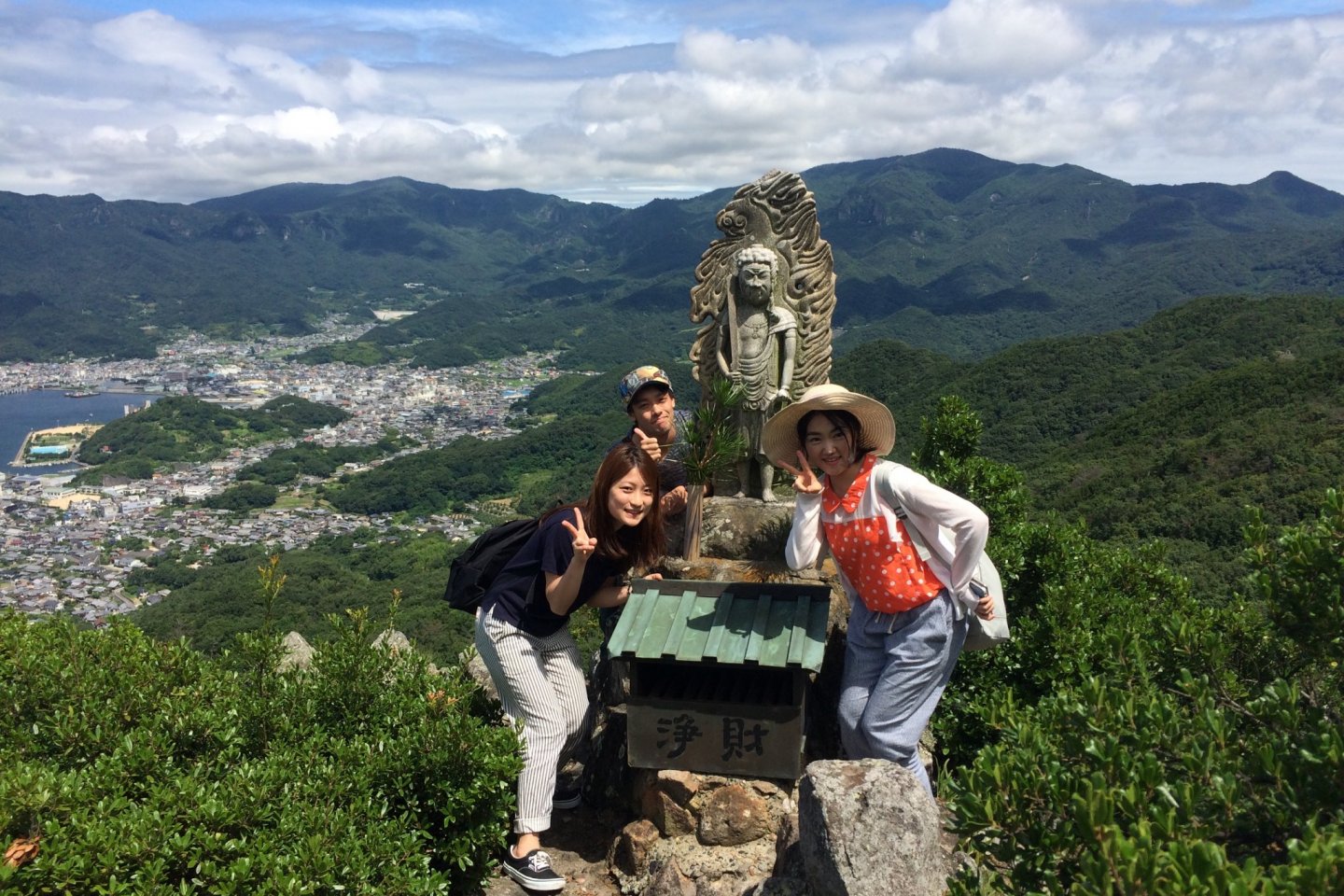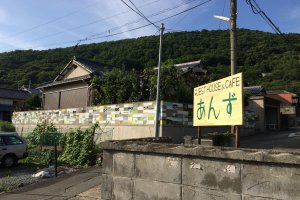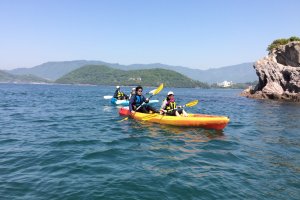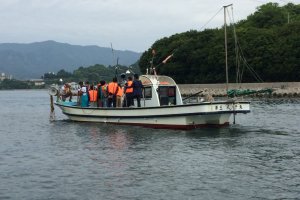Shodoshima Island’s warm Mediterranean climate, beautiful coastal resorts and breathtaking mountain scenery are reminiscent of Greece and make the island a popular year-round destination. Shodoshima literally means “small beans island”. Since 1908, the warm climate helped Shodoshima to become the first place in Japan to successfully cultivate olives making it the country’s top producer.
Highlights of Shodoshima
In the centuries before Shodoshima became known as “Olive Island,” the cultivation of soy beans gave rise to an enduring soy sauce industry. The town of Shodoshima is home to around a dozen soy sauce manufacturers. The company of Marukin, one the island’s largest soy sauce producers, maintains a museum on its factory grounds detailing for visitors what the traditional soy sauce-making process is like.
In terms of local cuisine, the traditional Shodoshima dish, “tsukudani,” meat or fish boiled in a sweet soy sauce, is often enjoyed with a bowl of rice. It can also be enjoyed with a bowl of another traditional item, Shodoshima somen noodles, thin almost thread-like noodles made from locally produced flour, water and salt, that is hand stretched and sun-dried on wooden racks.
Don’t Miss
Olive Park
Shodoshima is less than 60 square miles (153 square kilometers), and is packed full of adventure. Olives that earned the island its nickname can be experienced at Olive Park (“Oribu-koen” in Japanese). Olive Park is a working olive grove on the site where olives were first cultivated. Hiking paths through the olive trees and along the hillsides present visitors with fantastic views of the olive grove, the Seto Inland Sea and its many islands, and a replica Greek windmill constructed with a nod towards its twinned island, Milos. The Olive Park’s museum features exhibits documenting the history of olive cultivation on the island and the growing process, and the restaurant, cafe and shops provide the opportunity to sample the many olive products. There is also the Sun Olive public bathhouse with 8 hot spring fed baths to allow visitors to relax, refresh, and enjoy the vistas of Shodoshima.
Kankakei Gorge
Water and wind have eroded the slopes of Mt. Hoshigajo, the highest point on Shodoshima and in the Seto Inland Sea at 2,676 ft (816 m), into a landscape of sheer volcanic cliffs. The vistas are amazing anytime of year, but the gorge is especially beautiful in the autumn when the maple trees erupt into unburning autumnal fire. A ropeway offers visitors a convenient way to take in the views. Both its top and bottom stations are accessible by car and bus for convenience. For the adventurous, a pair of hiking trails wind their way through the forest and on to the twin peaks that make up the summit of Mt. Hoshigajo. Natural stone arches, the ruins of a 14th century castle, various shrines, and expansive views are the reward of intrepid hikers.
Angel Road
Shodoshima is home to the Angel Road tidal island. Located near the Port of Tonosho, Angel Road is a sandbar that connects three small uninhabited islands to Shodoshima at low tide. Local lore encourages couples to hold hands as they walk the sandbar to “discover happiness” in their relationship. Low tide occurs twice a day. Angel Road is most scenic as the tide starts to pull out and in the time before it slips beneath waves.
Setouchi Triennale
Started in 2010, the Setouchi Triennale inspires installation artists from Japan and internationally to create unique art pieces on several islands throughout the Seto Inland Sea. Some of these pieces are permanent, while others are only there for their triennale. The forthcoming triennale will be in 2019.
Experience Shodoshima
A visit to Shodoshima provides plenty of opportunities to experience the local island and seaside culture, with several guest houses also good lodging options to meet the locals.

Sea Kayaking, Cruising and Fishery Experience Tours
In addition to all the natural wonders and unique local culture and events, sea kayaking, fishery experience, and public and chartered cruise, cycling and historic town tours with Shodoshima Tours provide fun and unforgettable experience to the adventurous traveler.
-
Sea Kayaking Grab a kayak and your friends and fellow travelers and follow your guide on a tour of the area’s uninhabited islands. Have the beaches and coves all to yourself and enjoy a swim in the sparkling blue waters of the Seto Inland Sea. The 2 hour twice daily tours (9:30am-11:30am and 1:30pm-3:30pm) are child and family friendly, and cost ¥5,000/adult and ¥3,000/child
-
Public or Chartered Cruises Twice daily public cruises (1pm-2:30pm and 3pm-4:30pm Saturdays, Sundays and holidays, 10am-11:30am and 1pm-2:30pm weekdays - ¥6,000/adult, ¥3,000/child) are with all the amenities one needs for a comfortable trip. Explore the scenic Okadonohana Lighthouse and to two uninhabited islands. A tea service is served at the second island before returning.
-
A chartered cruise can be reserved for up to 7 hours (¥80,000 for a 7 hour chartered cruise) and permit guests to see more islands on the Seto Inland Sea. A chartered cruise can be a great way to experience the Setouchi Triennale. They can also be reserved for 2 hour (¥25,000), 3 hour (¥37,000), and 4 hour (¥50,000) durations. Both public and chartered cruises have a capacity of 10 people.
-
Fishery Experience Learn the secrets of generations of the fishing trade from local fisherman as they show you great local fishing holes and how to get the most from of them.
-
Cycling Tour A full day (9am-4pm) cycling tour that includes olive oil and somen noodle-making experiences, lunch, dessert and more is available for only ¥6,000/person.
-
Historic Walking Tour Enjoy the historic atmosphere and traditional architecture of Sakate Village with the help of a local guide. Tours are from 8am-9:30am every day and are just ¥1,500/adult and ¥1,000/child.
-
88 Temple Pilgrimage Similar to Shikoku Island to the south, Shodoshima boasts its own Buddhist temple pilgrimage. There are 88 temples on the route ranging from tiny rustic structures to large modern meditation halls. The entire route takes about 2 weeks to complete on foot.

Stay
Guesthouse and Cafe Anzu
Guesthouse and Cafe Anzu is a convenient, rustic and affordable dormitory style accommodation built in a renovated 50 year old farm house. It has 3 rooms, one for men, one for women, and one that can be chartered by individual groups. Each room sleeps 3 people and costs just ¥3,500/person/night. The cafe serves a simple breakfast set, pasta, and Shodoshima kakemaze gohan (rice with vegetables and seafood mixed in). Guests at Anzu receive a discounted breakfast at the cafe. Anzu located 150m up the mountain from Sakate’s only stoplight, near Sakate Port.

Guesthouse Genza
Sister Store to Guesthouse and Cafe Anzu, Guesthouse Genza is located just 3 minutes walk from Sakate Port. This renovated farmhouse features 3 rooms (one 4 person and two 2 person rooms). They can be used as same-sex dormitories (¥3,000/person/night) or rented out for an individual group (2 person room ¥6,000/night, 4 person ¥12,000/night). Guests at Genza receive a discount for breakfast at Cafe Anzu and, through Genza’s association with the local tourism office, have easy access to many of Shodoshima’s available tours.
































